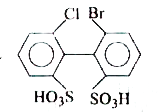In which of the following cases functional isomerism is not possible?
C2H6O
C3H6O
CH2O
C4H8O2
To determine in which case functional isomerism is not possible, we need to analyze each option based on the definition of functional isomerism. Functional isomers are compounds that have the same molecular formula but different functional groups.
1. Identify the Options: The question provides four molecular formulas:
- C2H6O
- C3H6O
- CH2O
- C4H8O2
2. Analyze Each Molecular Formula:
- C2H6O:
- Possible isomers:
- CH3CH2OH (an alcohol)
- CH3OCH3 (an ether)
- Conclusion: Functional isomerism is possible.
- C3H6O:
- Possible isomers:
- CH3CH2CHO (an aldehyde)
- CH3C(=O)CH3 (a ketone)
- Conclusion: Functional isomerism is possible.
- CH2O:
- Possible isomers:
- HCHO (formaldehyde)
- Conclusion: There are no other functional groups possible with this molecular formula. Therefore, functional isomerism is not possible.
- C4H8O2:
- Possible isomers:
- CH3CH2CH2C(=O)OH (a carboxylic acid)
- CH3CH2C(=O)OCH3 (an ester)
- Conclusion: Functional isomerism is possible.
3. Final Conclusion:
- The only molecular formula that does not exhibit functional isomerism is CH2O.
Answer:
Functional isomerism is not possible for CH2O.
- C2H6O
- C3H6O
- CH2O
- C4H8O2
- C2H6O:
- Possible isomers:
- CH3CH2OH (an alcohol)
- CH3OCH3 (an ether)
- Conclusion: Functional isomerism is possible.
- C3H6O:
- Possible isomers:
- CH3CH2CHO (an aldehyde)
- CH3C(=O)CH3 (a ketone)
- Conclusion: Functional isomerism is possible.
- CH2O:
- Possible isomers:
- HCHO (formaldehyde)
- Conclusion: There are no other functional groups possible with this molecular formula. Therefore, functional isomerism is not possible.
- C4H8O2:
- Possible isomers:
- CH3CH2CH2C(=O)OH (a carboxylic acid)
- CH3CH2C(=O)OCH3 (an ester)
- Conclusion: Functional isomerism is possible.
- The only molecular formula that does not exhibit functional isomerism is CH2O.
Functional isomerism is not possible for CH2O.
Topper's Solved these Questions
- ORGANIC CHEMISTRY : SOME BASIC PRINCIPLES AND TECHNIQUES BOOK - AAKASH INSTITUTE ENGLISHCHAPTER - ORGANIC CHEMISTRY : SOME BASIC PRINCIPLES AND TECHNIQUES EXERCISE - Assignment(SECTION-A)
68 Videos
- ORGANIC CHEMISTRY : SOME BASIC PRINCIPLES AND TECHNIQUES BOOK - AAKASH INSTITUTE ENGLISHCHAPTER - ORGANIC CHEMISTRY : SOME BASIC PRINCIPLES AND TECHNIQUES EXERCISE - Assignment(SECTION B)
6 Videos
- ORGANIC CHEMISTRY : SOME BASIC PRINCIPLES AND TECHNIQUES BOOK - AAKASH INSTITUTE ENGLISHCHAPTER - ORGANIC CHEMISTRY : SOME BASIC PRINCIPLES AND TECHNIQUES EXERCISE - Try Yourself
28 Videos
- MOCK_TEST_20BOOK - AAKASH INSTITUTE ENGLISHCHAPTER - MOCK_TEST_20EXERCISE - EXAMPLE
29 Videos
- ORGANIC CHEMISTRY: SOME BASIC PRINCIPLE AND TECHNIQUESBOOK - AAKASH INSTITUTE ENGLISHCHAPTER - ORGANIC CHEMISTRY: SOME BASIC PRINCIPLE AND TECHNIQUESEXERCISE - TRY YOURSELF
28 Videos
Similar Questions
Knowledge Check
In which of the followinng functional group isomerism is not possible?
AAlcoholsBAldehdyesCAlkyl halidesDCyanidesWhich of the following will show optical isomerism?
A B
B C
C D
D
Geometrical isomerism is not possible in
View SolutionWhich of the following shows coordination isomerism?
View SolutionWhich of the following complexes ionization isomerism ?
View SolutionWhich of the following shows configurationally isomerism ?
View SolutionWhich of the following will show optical isomerism?
View SolutionWhich of the following can show conformational isomerism:
View Solution

